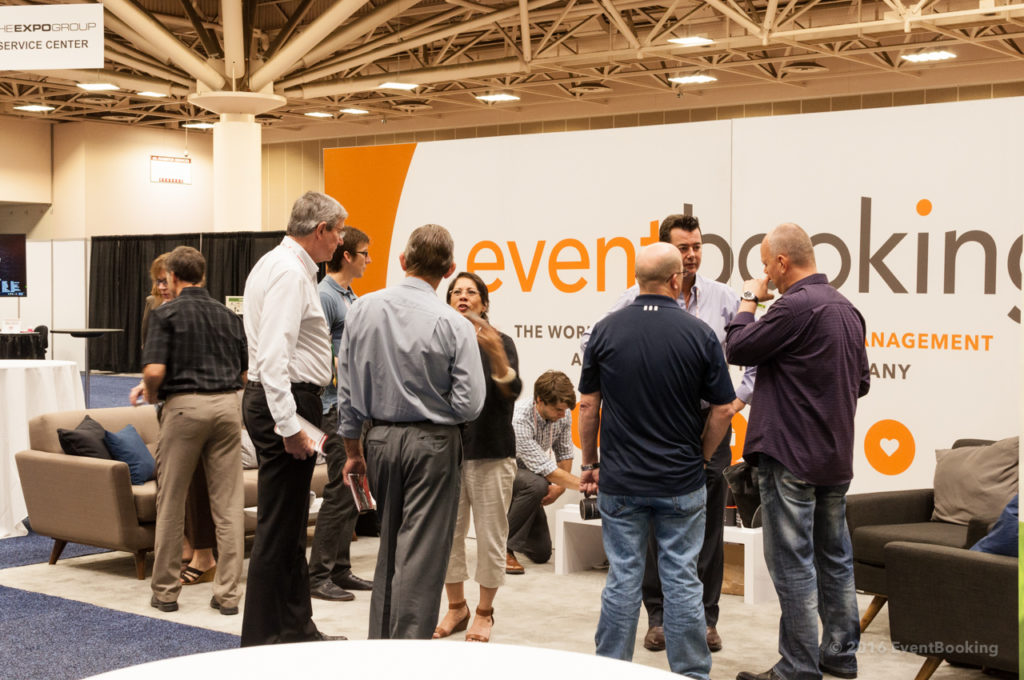Allied Corner: Networking 2.0

A version of this post originally appeared on EventBooking’s blog and is republished with permission.
For those of us that work in the events industry, trade show exhibiting and conference attendance is a large part of our marketing budget. So how can we make sure that we spend our time and marketing dollars effectively at industry events?
Most people will consider the number of leads a show generated (and then subsequent sales) as the primary way of measuring a return on investment. This is certainly the most obvious benefit we want to reap from a show, but what if an event does not directly provide leads?
It can provide an opportunity for Networking 2.0.
Networking should be reimagined for the purpose of gauging the general sentiment on three primary issues:
- The perception of your company and products
- The perception of other companies and products
- The state of the industry
This is Networking 2.0 because it’s twice as valuable as a stack of business cards and cold or lukewarm leads.
In addition to paying attention to what your customer says about your company, pay even more attention to what they stop saying about it. If you hear less and less praise, it doesn’t mean they have stopped using your product. What it does mean, however, is that they are not as engaged as they previously were.
This approach to networking is instrumental because it offers insight about when a company has lost credibility, has started to lose direction, or has strayed away from the values that clients initially loved about it.
Additionally, Networking 2.0 is a great chance to let people express how they perceive the current financial climate at their company. If they start talking about “hiring freezes,” it could be that they are anticipating an economic downturn. Take note of this, because it might be time to revise budgets yourself. Conversely, when people speak of expansions and new initiatives, this could be a signal that their business is going well. Such information could also reflect the state of the industry as a whole.
The rewards we reap from attending an industry event should go far beyond the potential revenue opportunities. It’s a unique chance to find out what is happening in the industry and how people perceive you and your products—through Networking 2.0.
2017 Charles A. McElravy Award Nominations Open

Deadline to submit nominations for the 2017 Charles A. McElravy Award is Nov. 30, 2016.
The Charles A. McElravy Award may be awarded annually to an IAVM Professional, Honorary, or Retired member who, in the opinion of the IAVM Board of Directors, has made the greatest lifetime achievement to the welfare of IAVM or profession.
The following criteria are established for the McElravy Award nominees:
- The nominee must have been an IAVM Professional, Honorary, or Retired member in good standing for at least 15 years total (though not necessarily consecutively).
- The nominee needs to meet the minimum service to IAVM requirements for Honorary Membership, but is not required to be retired. The following criteria must be met for a member to be eligible for consideration for Honorary Membership: 1) Attendance at no fewer than 10 Annual Conferences (VenueConnect) during the past 15 years; 2) Attendance at no fewer than five Region Meetings during the past 15 years; 3) Service as chair of at least three international or two Region committees during the past 15 years; 4) Service as: Director of IAVM or officer in a Region at least once during the member’s tenure with IAVM or b) Program chair for an IAVM venue-specific or specialty meeting during the member’s tenure with IAVM or c) Member of Board of Regents, Board of Trustees, or Board of Governors during member’s tenure with IAVM.
- Any member in good standing may make a nomination, which must provide, in writing, a minimum of three examples of the nominee’s outstanding contributions to IAVM and/or the industry (for example: leadership, accomplishments, professional service/activities, projects/results).
- At least three letters of recommendation must accompany the nomination letter.
- No IAVM Chairman of the Board (or past president) is eligible for consideration until the third annual conference (VenueConnect) following his/her term of office.
- Previous recipients are ineligible (and may be found on our website under Legacy of Leaders).
The nominations and letters of recommendation should be written to IAVM President and CEO Brad Mayne, CFE, and submitted to Rosanne Duke electronically. The nomination letter and all letters of recommendation must be received by close of business Nov. 30, 2016. If you have any questions, please contact Rosanne Duke at 972.538.1025.
IAVM Launches New Podcast Series—The Venue: Coffee Break with Alexis and Shelley

IAVM is expanding its podcast circle with a new series, The Venue: Coffee Break with Alexis and Shelley. It is an addition to the successful series, The Venue, which airs monthly and is a call-in show that includes live chats straight from the headlines of IAVM’s VenueNet member forum and issues we face every day.
The Venue: Coffee Break will also include live chats and will be hosted by IAVM members Alexis Berggren, director of event services at the New Orleans Ernest N. Morial Convention Center, and Shelley Ellis, general manager of the Visalia Convention Center. It will also include special guests.
The first episode of the new series was live at VenueConnect 2016 in Minneapolis, Minnesota, and featured Mark Gnatovic, senior vice president of SearchWide, a company that provides executive search services to convention centers, arenas, exhibition, and event companies. During this episode, Mark discussed how resumes have changed in recent years, the impact of LinkedIn, and what each of us can be doing on LinkedIn to stay relevant.
Future episodes will cover a range of topics, and will be designed to educate and entertain. The second episode will be The Venue: Coffee Break “Human Resource Edition.” Alexis and Shelley will discuss human resource issues and employee evaluations with Kelli Zohar-Davis, SPICE training manager at the New Orleans Ernest N. Morial Convention Center. Other upcoming topics will include:
- An interview with Brad Mayne, CFE, IAVM’s president and CEO. During this interview, we will all gain insight on Brad’s first few months as president and CEO, the future of IAVM, and ask Brad the question: “What would you tell your younger self when you first started this industry?”
- Book Club Edition – The first book that will be featured is The Girls Guide to Being a Boss (Without Being a Bitch): Valuable Lessons, Smart Suggestions, and True Stories for Succeeding by Caitlin Friedman and Kimberly Yorio. This one is sure to have some laughs. Grab your copy.
- Social Media Success Stories – Alexis and Shelley will interview a firsthand expert in our industry.
- Venue Horror Stories – We each have them, and we want to hear yours. Let’s laugh together.
Listeners can expect to have fun, relax, sit back, and enjoy chatting along with Alexis, Shelley, and special guests, but also hear about venue related trends and news content you crave.
“We want to provide information to IAVM members and listeners in an alternate way while having a lot fun,” Alexis and Shelley said. “We are all in this together and this podcast won’t be perfect. We will definitely have fun and we will make fools of ourselves at times, but we love what we do and we want to share our passion with others and want to hear from each of you. We are all on this journey together and the more we can share the better we can each become at what we do.”
Take a coffee break along with Alexis and Shelley! The next podcast will be Friday, October 7, and you can register here.
U.S. House Passes Bill to Delay Overtime Rule, and IAVM’s Letter to Congress

The U.S. House of Representatives voted on Wednesday 246-177 to delay the Labor Department’s upcoming overtime rule by six months. The rule is set to take effect on December 1. The U.S. Senate would need to pass legislation, also, to delay the bill. However, Congress is adjourned until November 14.
“We all agree we need to modernize our nation’s overtime rules, but small businesses, nonprofits, and colleges and universities should not be hurt in the process,” said Congressman Tim Walberg (R-Mich.), who introduced the bill, in a statement. “The department needs to abandon this flawed rule and pursue the balanced approach we’ve been fighting for from the start. Instead, they are forcing those who have to deal with the real-world consequences to make significant changes before an arbitrary December deadline. While the department continues to ignore widespread concerns, the House has taken an important bipartisan step to provide hardworking Americans more time to implement this expansive rule. The administration should do the right thing and approve this much-needed delay.”
The White House threatened to veto the bill.
“While this bill seeks to delay implementation, the real goal is clear—delay and then deny overtime pay to workers,” the White House said in a statement. “With a strong economy and labor market, now is a good time for employers to provide these essential protections for workers, who cannot afford to wait.”
IAVM leadership—represented by President and CEO Brad Mayne, CFE, and 2016-2017 Chair Mark Mettes, CFE—sent a letter to Rep. Kurt Schrader (D-Ore.) on Wednesday in support of his proposed bill, the ” Overtime Reform and Enhancement Act.” The complete letter is as follows:
Dear Congressman Schrader,
On behalf of more than 5,500 public assembly venues and suppliers, the International Association of Venue Managers extends our support for the Overtime Reform and Enhancement Act.
IAVM represents public assembly venues from around the globe. Members include managers and senior executives from auditorium, arenas, convention centers, exhibit halls, stadiums, performing arts centers, university complexes, and amphitheaters. IAVM also counts more than 500 Allied companies among its members. These companies provide products and services used by venue managers.
When the Department of Labor’s final rule, entitled “Defining and Delimiting the Exemptions for Executive, Administrative, Professional, Outside Sales and Computer Employees,” takes effect December 1, 2016, it will more than double the salary test of those now eligible for overtime from $23,660 to $47,776 without any adjustment to reflect wide regional variations in the cost of living and will permanently index the threshold for inflation.
This will have a dramatic effect on personnel cost by greatly expanding the number of employees eligible for overtime pay. Reclassifying employees from salaried to hourly will limit an employer’s flexibility, bonus and incentive pay while demoralizing many more employees who would now be subjected to punching a time clock. In the long run, this rule will have the unintended consequence of reducing employee benefits and serve as a detriment to future hiring. The DOL ruling adds another increased cost for our membership that will lead to future consolidation in our industry and have a dramatic impact.
For these reasons, we believe the Overtime Reform and Enhancement Act provides a much more reasonable timeline for organizations to comply with this significant payroll burden, starting with a salary threshold increase to $35,984 on December 1, 2016, with additional, incremental increases phased in over the next three years. IAVM also supports the provision in the bill that would eliminate the automatic increase to the salary threshold every three years to maintain the threshold at the 40th percentile of full-time salaried workers. This proposed salary threshold should also be subject to public notice and comment periods consistent with the rulemaking process.
We strongly support your efforts.
IAVM members should be following this story with the understanding and preparation that as of today, September 30, the effective date for the overtime rule will stay December 1. Continue due diligence with your HR department and attorneys to stay up to date on the rule and any changes to it. The U.S. Department of Labor is also a good source for updates.
Our Top Five Favorite Instagram Photos of the Week

Here’s where we spotlight some of our favorite Instagram photos we’ve seen from the past week. The photos are from members and venues worldwide. If you haven’t followed us on Instagram yet, now is a good time. We may just include your photos in a future post.
By following us, you’re also entered into our monthly drawing where you can win such prizes as conference registrations, full-page ads in FM magazine, and textbooks. Congratulations to Bridgestone Arena, who is our recent winner. The next drawing will be in October.
Behold, this week’s top five!
Do you want to receive a Front Row News weekly digest?
Categories
- Allied (861)
- Architecture (147)
- Arenas (747)
- Career (897)
- Convention Centers (895)
- Education (623)
- Events (1,544)
- Food & Beverage (193)
- Foundation (113)
- Guest Experience (1,496)
- Industry News (2,270)
- Leadership (1,888)
- Marketing (150)
- Membership (2,000)
- Music (213)
- Performing Arts Centers (454)
- Professional Development (409)
- Research (127)
- Safety & Security (442)
- Sports (763)
- Stadiums (608)
- Student (159)
- Technology (516)
- Ticketing (92)
- Touring (82)
- Trends (364)
- Uncategorized (725)
- Universities (218)
- Video (25)
- Young Professional (198)
Twitter Feed
- Twitter feed loading
Recent Posts
- McNamara Named General Manager of Will Rogers Memorial Center
- Matt Rife Breaks Record for Most Tickets Sold for a Comedy Show at Honda Center
- The Events Industry Council Recognizes the Miami Beach Convention Center (MBCC) for Achieving Gold Level Sustainability Certification
- Raleigh Convention Center Shares Designs of Upcoming Expansion
- Acrisure Arena Wraps ‘Magnificent 7’ with Record-Setting Week of Live Entertainment, Welcoming Fans from All 50 States
Categories
- Allied
- Architecture
- Arenas
- Career
- Convention Centers
- Education
- Events
- Food & Beverage
- Foundation
- Guest Experience
- Industry News
- Leadership
- Marketing
- Membership
- Music
- Performing Arts Centers
- Professional Development
- Research
- Safety & Security
- Sports
- Stadiums
- Student
- Technology
- Ticketing
- Touring
- Trends
- Uncategorized
- Universities
- Video
- Young Professional
Archives
- November 2025
- October 2025
- September 2025
- August 2025
- July 2025
- June 2025
- May 2025
- April 2025
- March 2025
- February 2025
- January 2025
- December 2024
- November 2024
- October 2024
- September 2024
- August 2024
- July 2024
- June 2024
- May 2024
- April 2024
- March 2024
- February 2024
- January 2024
- December 2023
- November 2023
- October 2023
- September 2023
- August 2023
- July 2023
- June 2023
- May 2023
- April 2023
- March 2023
- February 2023
- January 2023
- December 2022
- November 2022
- October 2022
- September 2022
- August 2022
- July 2022
- June 2022
- May 2022
- April 2022
- March 2022
- February 2022
- January 2022
- December 2021
- November 2021
- October 2021
- September 2021
- August 2021
- July 2021
- June 2021
- May 2021
- April 2021
- March 2021
- February 2021
- January 2021
- December 2020
- November 2020
- October 2020
- September 2020
- August 2020
- July 2020
- June 2020
- May 2020
- April 2020
- March 2020
- February 2020
- January 2020
- December 2019
- November 2019
- October 2019
- September 2019
- August 2019
- July 2019
- June 2019
- May 2019
- April 2019
- March 2019
- February 2019
- January 2019
- December 2018
- November 2018
- October 2018
- September 2018
- August 2018
- July 2018
- June 2018
- May 2018
- April 2018
- March 2018
- February 2018
- January 2018
- December 2017
- November 2017
- October 2017
- September 2017
- August 2017
- July 2017
- June 2017
- May 2017
- April 2017
- March 2017
- February 2017
- January 2017
- December 2016
- November 2016
- October 2016
- September 2016
- August 2016
- July 2016
- June 2016
- May 2016
- April 2016
- March 2016
- February 2016
- January 2016
- December 2015
- November 2015
- October 2015
- September 2015
- August 2015
- July 2015
- June 2015
- May 2015
- April 2015
- March 2015
- February 2015
- January 2015
- December 2014
- November 2014
- October 2014
- September 2014
- August 2014
- July 2014
- June 2014
- May 2014
- April 2014
- March 2014
- February 2014
- January 2014
- December 2013
- November 2013
- October 2013
- September 2013
- August 2013
- July 2013
- June 2013
- May 2013
- April 2013
- March 2013
- February 2013
- January 2013
- May 2012
- March 2012
- December 2011
- November 2011
- October 2011
Recent Comments
- Frank Bradshaw, Ph.D., CVE on John Meyer, CVE, a Tireless Advocate of Certification for Venue Professionals, Has Died
- Neil Sulkes on Hilary Hartung, Friend to Many in Venue Marketing, Has Left Us
- Jason Parker, CVE on The Devastation of Hurricane Helene and How We Can Support One Another
- Larry Perkins on Touhey Testifies Against Speculative Ticketing Before Congressional Subcommittee
- Peter Secord on Major Players for Planned Elkhart Amphitheater Were in the Mix at VenueConnect
